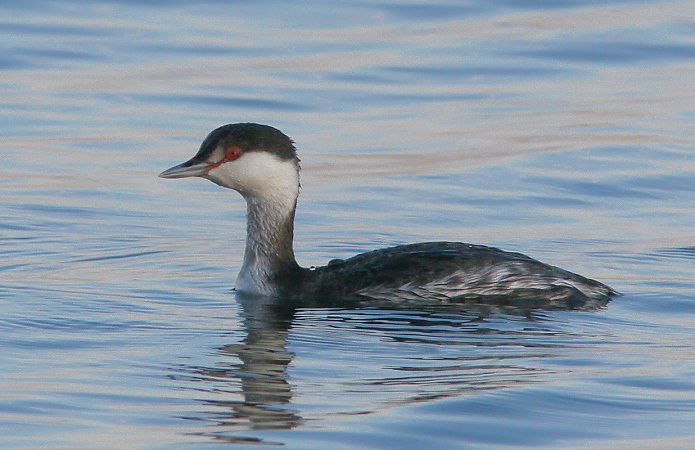
Date: 2006-12-31
Lens: Canon 300mm IS F4 + 1.4x II Converter

 Horned Grebe
Podiceps auritus
Horned Grebe
Podiceps auritus
 Description
Description
The "horns" of the Horned Grebe are formed by golden-yellow feather patches located behind its eyes. The bird can raise and lower its "horn" feathers at will. The Horned Grebe regularly eats some of its own feathers, enough that its stomach usually contains a matted plug of them. This plug may function as a filter or may hold fish bones in the stomach until they can be digested. The parents even feed feathers to their chicks to get the plug started early. The Horned Grebe dives underwater for fish, crustaceans, and other small aquatic animals in both open water and among aquatic vegetation. It also picks insects off the water surface.
Like other grebes, chicks are often carried around between the wings on the parent's back. In fact, the parent may dive underwater with the chick on its back!
General: Sexes similar. 12 to 15 inches in length.
Adult Alternate: Chestnut lores, neck, breast, and flanks. Blackish crown and back. Dirty white belly. Black, fan-shaped facial feathers. Golden-yellow tuft of feathers extending from behind the eye to the back of the head. Red eye. Thin dark bill with whitish tip. Relatively flat head with slight peak toward the rear.
Adult Basic: White cheeks extending back toward nape. Blackish crown, hind neck, and back. Grayish-white lores. White foreneck, somewhat dirty white toward the base, flanks, and belly.
Immature: Similar to adult basic.
Breeds on small to moderate-sized, shallow freshwater ponds and marshes. Winters along coasts and on large bodies of water.
 Nesting
Nesting3-8 white to brownish or bluish green eggs. The eggs have a 14-16 day incubation period. Fledging occurs in 15-18 days. The nest an open bowl built on a platform of floating vegetation or on a rock.